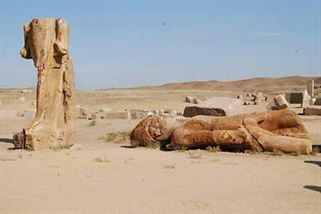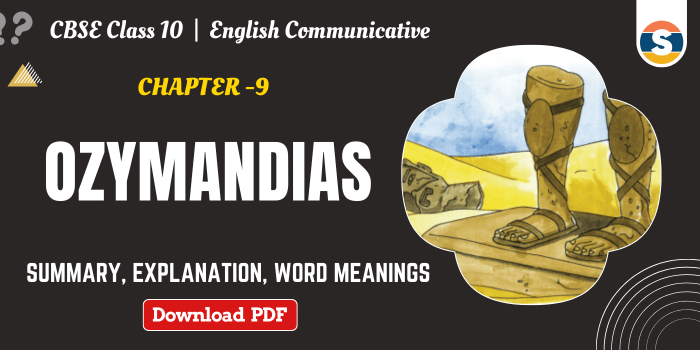By Ruchika Gupta
CBSE Class 10 English Chapter 9 Ozymandias Summary, Explanation along with Difficult Word Meanings from Literature Reader (Communicative) Book
Ozymandias Summary of CBSE Class 10 English Poem and detailed explanation of the poem along with meanings of difficult words and literary devices used in the poem. Also, the Summary of Ozymandias is followed by an explanation of Ozymandias lesson.
- Ozymandias Summary
- Ozymandias Previous Year Questions with Model Answers PDF
- Ozymandias Summary in Hindi
- Ozymandias Explanation
- Literary Devices of Ozymandias
Related:
- Class 10 Ozymandias (important) Questions and Answers
- Ozymandias MCQ
- Ozymandias Previous Years Question with Answers
Ozymandias PDF Download here
Ozymandias Summary
This is a sonnet (a poem of fourteen lines – the first eight form an octave and the next six form a sestet).
It is about a ruined statue which has become so with the passage of time and here, we can correlate it with Shakespeare’s sonnet ‘Not marble, nor the gilded monuments.
The title ‘Ozymandias’ is the throne name of Egyptian king Ramesses. The poem talks about his foolish desire to immortalize himself by erecting a huge statue in the middle of the vast desert.
Once the poet meets a person who has been to an ancient place in the deserts that is Egypt. He tells the poet about the ruined statue of the great powerful king, Ozymandias. It had been destroyed with the passage of time.
Now, there were only the two legs which stood on a platform and the upper part of the body was nowhere to be seen. The face of the statue lay buried in the sand, at a distance. He praises the talent of the sculptor. He had perfectly copied the minutest expressions of hatred and emotionlessness from the king’s face onto the statue’s visage. The wrinkles of the king’s face had also been perfectly copied by him. Now that the king was no longer alive, yet the expressions were there to be seen on the visage of the statue.
The engraving on the platform reflects the pride and arrogance of king Ozymandias. As the statue is now destroyed, the engraving is a mockery at the pride and ego of the king. It asked all to see the king of kings – King Ozymandias. The mighty rulers would see the great statue and feel themselves to be worthless.
Today, after the passage of so many centuries, finally there is no trace of the king’s accomplishment in the vast stretch of the desert. One can only see the remains of the destroyed statue in the vast and empty desert.
Top
Ozymandias Previous Year Questions with Model Answers PDF
Download the previous year questions of the Lesson Ozymandias of class 10 (Communicative) for free. With the help of this, you can prepare for the exam.
To Download Ozymandias Previous Year Questions with Model Answers- Click Here
Ozymandias Summary (in Hindi)
यह एक सॉनेट (चौदह पंक्तियों की एक कविता – पहले आठ एक सप्तक बनाते हैं और अगले छह एक सेस्टेट बनाते हैं) है। यह एक खंडहर मूर्ति के बारे में है जो समय बीतने के साथ ऐसी हो गई है और यहाँ, हम इसे शेक्सपियर के सॉनेट ‘न संगमरमर, न ही सोने का पानी चढ़ा स्मारकों’ से सहसंबंधित कर सकते हैं। शीर्षक ‘ओज़ीमंडियास’ मिस्र के राजा रामेसेस का सिंहासन नाम है। कविता विशाल रेगिस्तान के बीच में एक विशाल मूर्ति खड़ी करके खुद को अमर बनाने की उनकी मूर्खतापूर्ण इच्छा के बारे में बात करती है। एक बार कवि एक ऐसे व्यक्ति से मिलता है जो रेगिस्तान में एक प्राचीन स्थान पर गया है जो मिस्र है। वह कवि को महान शक्तिशाली राजा, ओज़ीमंडियास की खंडहर मूर्ति के बारे में बताता है। यह समय बीतने के साथ नष्ट हो गई थी। अब, केवल दो पैर थे जो एक मंच पर खड़े थे और शरीर का ऊपरी हिस्सा कहीं नहीं दिख रहा था। मूर्ति का चेहरा कुछ दूरी पर रेत में दबा हुआ था। वह मूर्तिकार की प्रतिभा की प्रशंसा करता है। उसने राजा के चेहरे से घृणा और भावनाहीनता के सूक्ष्मतम भावों को मूर्ति के चेहरे पर पूरी तरह से कॉपी कर दिया था। राजा के चेहरे की झुर्रियाँ भी उसने पूरी तरह से कॉपी कर ली थीं। अब जबकि राजा जीवित नहीं था, फिर भी मूर्ति के चेहरे पर भाव देखे जा सकते थे। मंच पर उत्कीर्णन राजा ओज़िमंडियास के गर्व और अहंकार को दर्शाता है। चूंकि मूर्ति अब नष्ट हो चुकी है, इसलिए उत्कीर्णन राजा के गर्व और अहंकार का मजाक उड़ाता है। इसने सभी को राजाओं के राजा – राजा ओज़िमंडियास को देखने के लिए कहा। शक्तिशाली शासक महान मूर्ति को देखेंगे और खुद को बेकार महसूस करेंगे। आज, इतनी शताब्दियों के बीतने के बाद, आखिरकार रेगिस्तान के विशाल विस्तार में राजा की उपलब्धि का कोई निशान नहीं है ।

Ozymandias Poem Explanation
Poem
 I met a traveller from an antique land
I met a traveller from an antique land
Who said: Two vast and trunkless legs of stone
Stand in the desert. Near them, on the sand,
Half sunk, a shattered visage lies, whose frown,
And wrinkled lip, and sneer of cold command,
Tell that its sculptor well those passions read
Which yet survive, stamped on these lifeless things,
The hand that mocked them, and the heart that fed;
Word meaning
Antique: old
trunkless: without the upper body (the main part of the body of a human being or an animal, excluding the head, neck, and limbs)
sunk: to descend below the surface of something
shattered: broken into pieces
visage: face
frown: expression of anger or displeasure
wrinkled: marks of lines or folds
sneer: facial expression of scorn or hostility in which the upper lip may be raised
cold: without feelings for others
command: domination or control
sculptor: an artist who makes sculptures
passions: refers to the expressions on the king’s face
read: interpreted
survive: continue to exist after his death
stamped: sculpted, printed or engraved
mocked: to copy something
Explanation of the above poem – The poet met a traveler who came from a remote land. He told the poet that he saw the remains of a statue in the desert. Two huge legs made of stone stood and the remaining part of the statue – the upper body was missing. Another part of the statue, the face lay on the sand nearby. It was damaged and broken into pieces. The face of the statue had expressions of displeasure and a taunting smile. The wrinkles and lines of the face were also there. The poet says that the sculptor who had made the statue had read the expressions on the Egyptian king Ramesses’s face very well as he was able to copy them onto his statue so accurately. These expressions continued to exist even after the king’s death through this lifeless statue. The sculptor’s hands copied the king’s ruthless expressions and mocked at them while the king’s stone heart brought out these expressions on his face.

Top
Poem
 And on the pedestal these words appear:
And on the pedestal these words appear:
“My name is Ozymandias, king of kings:
Look upon my works, ye Mighty, and despair!”
Nothing beside remains. Round the decay
Of that colossal wreck, boundless and bare
The lone and level sands stretch far away.
Word meaning
Pedestal: the base of a statue
Mighty: the powerful kings of the world
Despair: without hope
beside: else
decay: broken pieces of the statue
colossal: extremely large or great
wreck: ruins
boundless: without limits
bare: without the great statue of Ozymandias
lone: the only survivor
Explanation of the above poem – At the base of the statue the words – “My name is Ozymandias, king of kings: Look upon my works, ye Mighty, and despair!” were engraved. The king introduced himself as Ozymandias, the most powerful king. He ordered all the powerful kings of the world to look at his huge statue and feel belittled in front of the mightiest king – Ozymandias. The poet says that now nothing else other than this engraving remains. The statue broke down with the passage of time and its broken pieces could be seen lying around. The vast desert stretched all around and it seemed to be endless. The statue of the great king Ozymandias was nowhere to be seen.
Ozymandias Literary Devices
1. Alliteration: cold command, survive stamped, boundless bare, sands stretch.
2. Consonance: ‘s’ and ‘t’ sounds are repeated-
Who said: Two vast and trunkless legs of stone
Stand in the desert. Near them, on the sand,
Half sunk, a shattered visage lies, whose frown,
3. Synecdoche: The hand that mocked them, and the heart that fed
4. Hyperbole: king of kings
5. Enjambment
6. Rhyme scheme: ababacdc efegeg
Important Videos Links
Also See:
- Julius Caesar Class 10 English Summary, Explanation, Difficult Words
- Snake Class 10 English Summary, Explanation, Difficult Words
- The Rime of the Ancient Mariner Class 10 English Summary, Explanation, Difficult Words
- Not Marble, nor the Gilded Monuments Class 10 English Summary, Explanation, Difficult Words
- Poem Mirror Class 10 English Summary, Explanation, Difficult Words
- The Frog and the Nightingale Class 10 English Summary, Explanation, Difficult Words
- VIRTUALLY TRUE Class 10 English Summary, Explanation, Difficult Words
- Two Gentlemen of Verona Class 10 English Summary, Explanation, Difficult Words
- The Letter Class 10 English Summary, Explanation, Difficult Words
- Mrs. Packletide’s Tiger Class 10 English Summary, Explanation, Difficult Words
- Patol Babu, Filmstar Class 10 English Summary, Explanation, Difficult Words
- Shady Plot Class 10 English Summary, Explanation, Difficult Words
- The Dear Departed Class 10 English Summary, Explanation, Difficult Words
- Class 10 Communicative English Important Character Sketches
- CBSE Class 10 English Communicative Study Guide
- CBSE Class 10 Communicative English Syllabus 2024-25
- CBSE Class 10 English Communicative word meanings
- Class 10 Communicative English (Important) Questions and Answers
- Descriptive Writing Class 10 Format, Examples
- Email Writing Class 10, 12 Formal, Informal Email Writing Format
- Article Writing for Class 10
